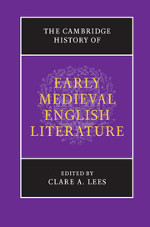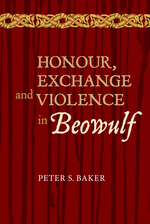Clare A. Lees (ed.), The Cambridge History of Early Medieval English Literature.
Cambridge: Cambridge University Press, 2012. xv + 789 pp. Hardback. 9-7805-2119-0589. £100.
To the chagrin of many Anglo-Saxonists, The Cambridge History of Medieval Literature
(ed. David Wallace), published in 1999, took 1066 as its starting point, thereby implicitly
consigning Anglo-Saxon literature to some kind of pre-medieval black hole. There was
one chapter, now increasingly unsatisfactory, on ‘Old English and its Afterlife’,
but, in accordance with institutional tradition at Cambridge, medieval English
literature was understood to mean post-Anglo-Saxon literature. This new publication
edited by Clare Lees admirably fills the gap left by the existing volume by presenting a
history of the earlier period (though, as a result, the title of the Wallace volume is
made to look even more problematic).
Lees has assembled a strong team of specialist scholars to produce an extremely
wide-ranging volume of twenty-six substantial chapters. She follows the example
of Wallace in including treatment not only of Old English and Anglo-Saxon Latin
literature but also of other traditions of writing in Britain and Ireland in the period,
both in vernacular languages and in other (non-Anglo-Saxon) strands of Latin. The
book is structured in three sections, which are broadly chronological in approach,
though chronology necessarily has to be deemphasized for some topics, not least Old
English poetry. The first section, Word, Script and Image, surveys early writings in
Britain and Ireland, down to about the ninth century, taking account of writing tech-
nologies and of the relation of art and writing and looking at texts in Irish and
Welsh as well as at traditions of insular Latin. The section ends by focusing
particularly on Bede in his historical and cultural context. The second section, Early
English Literature, presents detailed studies of major strands and genres of Old English
literature, with due attention too to related Latin writings. The recognized landmarks of
the Old English canon – Beowulf, lyrics and riddles, religious poetry, ‘Alfredian’ prose,
and so on – receive thoughtful attention here but the canon is also interestingly
refreshed by the inclusion of chapters on, for example, liturgical and devotional texts
and the relics of early women’s writing. The third section, Latin Learning and the Literary
Vernaculars, is broadly ‘later’ in its focus, covering roughly the period 900-1150
(though of course some of the writings treated in the second section, including
those of Ælfric and Wulfstan, are also ‘later’). Scientific and legal writings are
among the areas expertly surveyed here, and, as well as a chapter giving an alert
assessment of the authority of English as a literary language in this period and one
insisting illuminatingly on the European dimension of eleventh-century literary
culture in England, there are accounts of other literary languages in use at the time in
Britain and Ireland: Latin, Anglo-Scandinavian, Welsh and Gaelic (though the link
of the latter to Anglo-Saxon England is surely more tenuous than is the case with
the others).
The message that emerges strongly from The Cambridge History of Early Medieval
English Literature is of the richness and multifariousness of insular writings but also
of connections and connectedness. Contexts of multilingualism and multiculturalism are
shown to prevail and cultural linkages are explored between different political ‘zones’
and between different ideologies. Grand narratives of literary and political history,
constructed in the period itself and in modern scholarship, are here excitingly
complicated as alternative perspectives are brought to bear. Such alternative per-
spectives are traced within individual chapters but also become apparent when
reading one chapter in the context of another: a bigger picture emerges.
The emphasis throughout the book is very much on versions of history. Thus, for
example, Bede’s story of the early English church is firmly placed in its Northumbrian
social context; the Anglo-Saxon Chronicle is shown to represent multiplicity, not only
when opposed to Celtic and Norman historiography but also across its own
contrasting manuscripts; female political and literary history, ‘overwritten’ by male
authority, is carefully excavated; King Alfred is confirmed as a key figure in the history of
literature but the complexity of ninth-, and early tenth-, century literary history is
stressed and Alfred’s place in it reassessed (following the lead of Malcolm Godden’s
recent work). This is a large book with an ambitiously wide focus. Depending on topic, there is some variation in approach among contributors. For topics less familiar to
Anglo-Saxonists the chapters mostly take the form of authoritative surveys. In the
coverage of Anglo-Saxon literature the contributors have been given more leeway,
often pursuing particular takes on the literature and presenting new readings.
Such readings are invariably interesting but are pursued at the expense of the
comprehensiveness of a more conventional history. As a result, there are gaps in
coverage. Judith is mentioned only in passing, for instance, Bible translation is not
considered, and there is no overview of homilies and hagiography; in the case of
hagiography the main focus is on some female saints and on Guthlac. Also,
although traditions of non-Anglo-Saxon literature are discussed in considerable
detail there is little on Old English’s closest linguistic relation Old Saxon, and the
Heliand in particular, though recognized as ‘the longest alliterative poem known to
have been produced in Anglo-Saxon England’ (p. 282), gets very few mentions.
Even a book as inclusive as this one can’t cover everything in detail, however, and
what is included is generally treated at a very high academic level indeed. The
Cambridge History of Early Medieval English Literature will take its place as the definitive
guide to and assessment of Anglo-Saxon literary history as presently conceived and
will be essential reading for all serious students of early English literature. There
are some proofreading glitches that have slipped through but Clare Lees is to be
congratulated on devising and carrying through an ambitious project that will serve
Anglo-Saxonists, including of course TOEBI members, well for the foreseeable future,
helping us to rethink literary history in productive ways. And, happily, Lees has got
CUP to acknowledge Anglo-Saxon literature as medieval.
Hugh Magennis
Queen’s University Belfast


